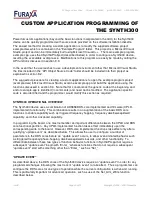
34 Canyon View Drive Orinda, CA., 94563 p:925.253.2969 f:925.253.4894
In some instances the user’s copy of Windows XP™ may be configured to never allow the installation
of unsigned drivers. In order change this configuration option follow these steps:
1.
Click on “Start” on the taskbar.
2.
Right Click on “My Computer”.
3.
Select “Properties” from the pop-up list.
4.
The “System Properties” dialog box will appear. Select the “Hardware” tab.
5.
In the “Drivers” section select the “Driver Signing” button. The “Driver Signing Options” dialog box will
appear.
6.
Change the default action to “Ignore” and click “OK”.
Having made this change, restart the machine and repeat the installation.
If using a 64-bit operating system then press F8 during boot-up and select "Disable Driver Signing"
each time the system is booted to allow the driver to load.
CONTINUING WITH THE SOFTWARE INSTALLATION IN VISTA, 2000 AND XP
Once the driver has been successfully installed, the GUI distributed with the Synth300 (Synth300
GUI.exe) can be executed from anywhere on the user’s hard-disk to control the configuration and
operation of the device.
RUNNING SYNTH300 PROGRAMS
The GUI provided (Synth300 GUI.exe) allows the user to specify each of the frequency and phase
profiles for each synthesizer, and select the active profile easily. Additionally, frequency sweeping
capabilities can be enabled and specified, and the board can be set for the two modes of external
modulation. This program will allow the user to access most, but not all, of the features of the
Synth300 board.
After selecting fields and entering the settings, the user simply clicks on the “Configure Board” button
to program the Synth300.
It is important to remember that no changes take effect until the user
selects “Configure Board”.
If a higher level of control is desired, the user may modify the C code provided in the example program
directory (example.dsw is a MS Visual Studio project containing all files necessary to create custom
user programs). The user library is provided in simple to use function calls, and the compiled driver is
supplied. Please refer to section 9 of this document for further detail.
r1v06
Page
13
of
31
Copyright © 2008 – 2010 Furaxa Inc.




























